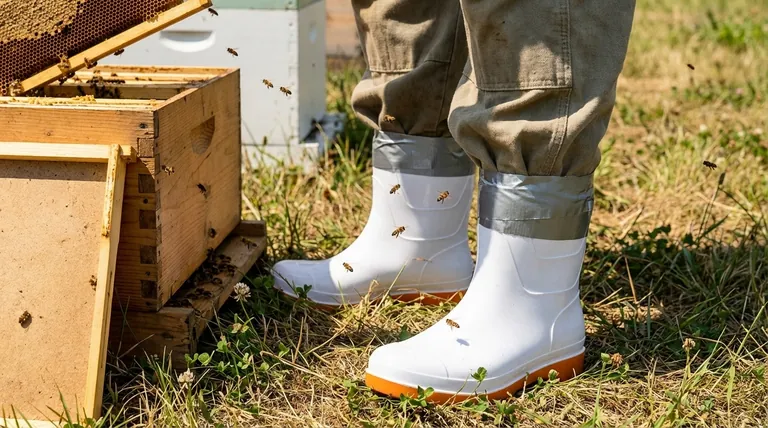The most critical rule for beekeeping attire is ensuring there are absolutely no gaps between your pants and your boots. Bees are natural explorers and climbers; they will find any small opening and crawl upwards, putting you at immediate risk of stings in a sensitive and difficult-to-reach area. This simple act of sealing your ankles is a non-negotiable step for a safe and calm hive inspection.
Preventing a bee from crawling up your pant leg is not just about avoiding a single sting. It's about maintaining the composure and focus required for responsible beekeeping, as a panicked reaction from you can agitate the entire hive.

Why a Small Gap Becomes a Big Problem
A tiny gap at your ankle may seem insignificant, but it represents a major vulnerability in your protective system. Understanding bee behavior is key to appreciating this risk.
The Climbing Instinct of Honeybees
Bees that land on you will almost always crawl upwards. An open pant leg is an inviting, dark, and warm space that mimics a natural cavity they might explore.
Once inside, the bee's primary goal is to get out. As it continues to climb, it will eventually find itself trapped against your skin, leading to a defensive sting.
Preventing the Chain Reaction
A single bee inside your suit is a significant distraction. Your natural reaction—to swat, run, or panic—sends alarm pheromones and vibrations through the colony.
This can trigger a defensive response from other bees, turning a calm inspection into a difficult situation. Sealing all entry points allows you to remain a calm and steady presence, which keeps the hive calm as well.
It's About Maintaining Your Focus
Effective beekeeping requires your full attention on the frames, the queen, and the health of the colony.
Worrying about a bee crawling up your leg is a mental distraction that detracts from your primary task. A fully sealed suit gives you the confidence to work methodically and without fear.
Understanding the Trade-offs and Common Mistakes
While the goal is a perfect seal, new beekeepers often make simple mistakes. Understanding these pitfalls is crucial for creating a truly bee-proof barrier.
Relying on a Simple Tuck
Just tucking your pants into your socks or boots is often not enough. Movement like bending or squatting can easily pull the fabric out, creating the very gap you were trying to avoid.
This method provides a false sense of security and is a common failure point.
Forgetting Other Entry Points
Ankles are the most common entry point, but they aren't the only one. Gaps at the wrists or around the neck veil can be just as problematic.
A proper beekeeping mindset involves viewing your entire suit as a sealed system, checking every potential opening—cuffs, zippers, and veil connections—before approaching a hive.
Choosing Inappropriate Clothing
Wearing thin pants like leggings or yoga pants is a mistake, even if tucked in. Bees can often sting directly through thin, tight material.
Loose-fitting, thick material like denim or canvas, combined with a proper seal at the ankle, provides two layers of crucial protection: one against crawling and one against the stinger itself.
How to Apply This to Your Hive Visits
Choosing the right method to seal your ankles depends on your gear and your commitment to best practices. Each approach ensures you can focus on your bees, not on your personal safety.
- If your primary focus is maximum security: Invest in a dedicated beekeeping suit or pants that have strong elastic or zippered closures built into the ankles.
- If your primary focus is adapting everyday clothing: Use wide duct tape or dedicated ankle straps to create an unbreakable seal between your pant legs and your boots.
- If your primary focus is building good habits: Before every hive visit, perform a full gear check, ensuring your ankles, wrists, and veil are completely sealed and there are no holes in your suit or gloves.
This small, deliberate action of sealing your ankles is the foundation of confident and peaceful beekeeping.
Summary Table:
| Aspect | Importance |
|---|---|
| Bee Behavior | Bees instinctively crawl upwards into dark, warm openings like pant legs. |
| Risk of Stings | A single bee inside can sting, causing pain and triggering a panic response. |
| Hive Agitation | Your panic releases alarm pheromones, potentially agitating the entire colony. |
| Maintain Focus | A sealed suit allows you to concentrate on the hive's health, not your safety. |
Work with confidence and peace of mind. For commercial apiaries and distributors, proper protective gear is the foundation of safe, efficient operations. HONESTBEE supplies the durable, reliable beekeeping supplies and equipment you need to protect your team and your investment. Let us help you outfit your operation with gear designed for professional use. Contact our wholesale team today to discuss your needs.
Visual Guide

Related Products
- Thick PVC Material Waterproof Anti-Slip Wear-Resistant Bee Work Shoes Boots for Garden Outdoor Utility
- Cotton Beekeeping Suit and Round Hat with Veil Bee Keeper Protective Gear
- Beekeeping Jacket with Hood and Veil for Beekeepers
- Economy Polyester Beekeeping Jacket with Veil and Hat
- Heavy Duty Cowboy Beekeeper Hat with Visibility Veil Outdoor Professional Beekeeping Protective Gear
People Also Ask
- What should be considered when choosing beekeeping boots? Ensure Maximum Safety and Comfort
- Why is it important to wear boots for beekeeping? Secure Your Apiary Safety from the Ground Up
- What are some examples of boots used for beekeeping? Essential Protection for Your Apiary Work
- Why is proper footwear important for beekeepers? Ensure Safety & Stability in the Apiary
- What is the importance of choosing the right beekeeping shoes? Ensure Safety and Comfort in the Apiary



















